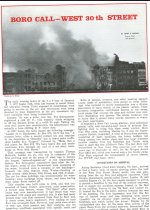As I remember it was during the 1970s, when the FDNY War Years had not only seen the heaviest fire activity, BUT also the MOST BORO CALLS.
After the 10 Alarm Boro Call in Bushwick, along with several others, including the 1977 Black Out, something had to be done.
Not only were individual buildings burning, but "BLOCKS WERE BURNING".
Companies would pull up to find 3 or 4 buildings going on arrival.
It was then that the city realized that something had to be done, and the city added 300 (?) additional Fire Marshalls in 1978.
They were known as Red Caps and were visible in the streets letting people know they are out there.
Although the fires continued into the 1980s, the FDNY Marshalls DID make a HUGE DENT in the amount of fires throughout the city, putting a much needed end to the FDNY WAR YEARS and so many people being hurt or even killed due to these fires.
After the 10 Alarm Boro Call in Bushwick, along with several others, including the 1977 Black Out, something had to be done.
Not only were individual buildings burning, but "BLOCKS WERE BURNING".
Companies would pull up to find 3 or 4 buildings going on arrival.
It was then that the city realized that something had to be done, and the city added 300 (?) additional Fire Marshalls in 1978.
They were known as Red Caps and were visible in the streets letting people know they are out there.
Although the fires continued into the 1980s, the FDNY Marshalls DID make a HUGE DENT in the amount of fires throughout the city, putting a much needed end to the FDNY WAR YEARS and so many people being hurt or even killed due to these fires.

